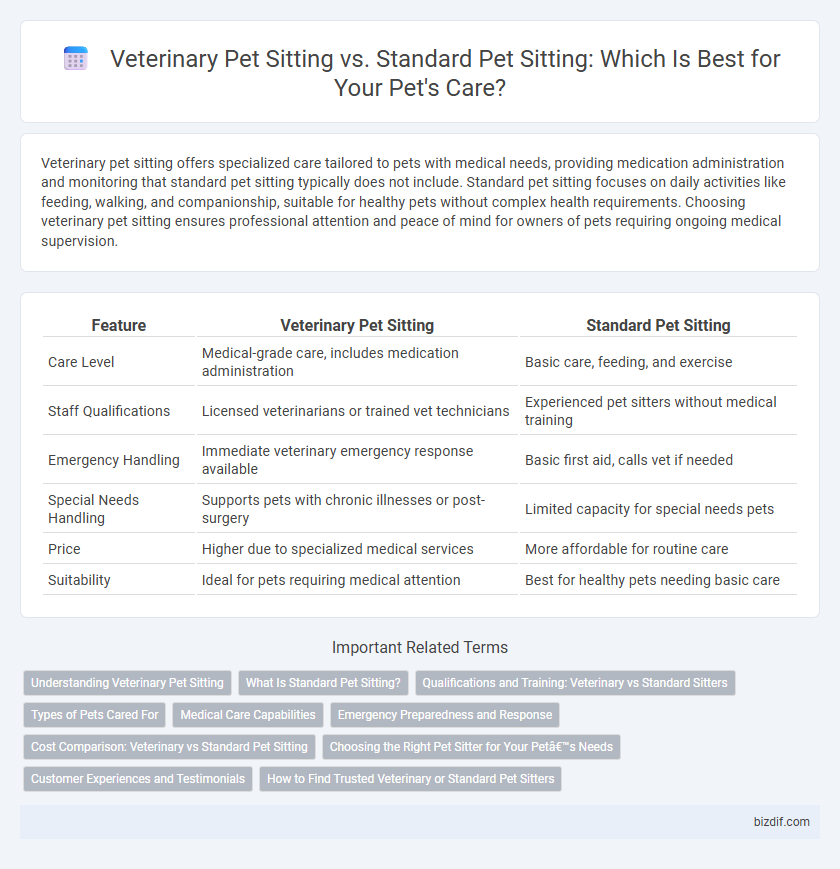Veterinary pet sitting offers specialized care tailored to pets with medical needs, providing medication administration and monitoring that standard pet sitting typically does not include. Standard pet sitting focuses on daily activities like feeding, walking, and companionship, suitable for healthy pets without complex health requirements. Choosing veterinary pet sitting ensures professional attention and peace of mind for owners of pets requiring ongoing medical supervision.
Table of Comparison
| Feature | Veterinary Pet Sitting | Standard Pet Sitting |
|---|---|---|
| Care Level | Medical-grade care, includes medication administration | Basic care, feeding, and exercise |
| Staff Qualifications | Licensed veterinarians or trained vet technicians | Experienced pet sitters without medical training |
| Emergency Handling | Immediate veterinary emergency response available | Basic first aid, calls vet if needed |
| Special Needs Handling | Supports pets with chronic illnesses or post-surgery | Limited capacity for special needs pets |
| Price | Higher due to specialized medical services | More affordable for routine care |
| Suitability | Ideal for pets requiring medical attention | Best for healthy pets needing basic care |
Understanding Veterinary Pet Sitting
Veterinary pet sitting involves specialized care provided by trained professionals who can administer medications, monitor chronic conditions, and respond to emergencies, ensuring comprehensive health management for pets. Unlike standard pet sitting, which primarily focuses on feeding, walking, and companionship, veterinary pet sitting integrates medical knowledge and collaboration with veterinarians. This advanced care option is essential for pets with complex medical needs, post-surgical recovery, or ongoing treatments requiring expert supervision.
What Is Standard Pet Sitting?
Standard pet sitting involves basic care services such as feeding, walking, and providing companionship to pets during their owner's absence. Unlike veterinary pet sitting, it does not include medical procedures, administering medications, or monitoring health conditions, focusing instead on maintaining pets' routine and emotional well-being. This service is ideal for pet owners seeking reliable daily care without the need for specialized medical expertise.
Qualifications and Training: Veterinary vs Standard Sitters
Veterinary pet sitters possess formal medical training and certifications, enabling them to administer medications, monitor chronic conditions, and provide specialized care for pets with health issues. Standard pet sitters typically have basic pet care experience but lack the advanced qualifications required for medical tasks and emergency interventions. The distinction in training ensures veterinary sitters can handle complex health needs, while standard sitters focus on routine feeding, exercise, and companionship.
Types of Pets Cared For
Veterinary pet sitting specializes in caring for pets with medical needs, including dogs, cats, birds, rabbits, and exotic animals requiring administration of medications, wound care, or post-surgical monitoring. Standard pet sitting typically covers routine care for common pets such as dogs, cats, fish, and small mammals like hamsters or guinea pigs, focusing on feeding, walking, and companionship. Veterinary pet sitters possess specialized training to manage pets with chronic illnesses, while standard pet sitters provide general care for healthy animals.
Medical Care Capabilities
Veterinary pet sitting offers advanced medical care capabilities, including administration of prescribed medications, wound care, and monitoring chronic conditions under the guidance of licensed veterinarians. Standard pet sitting primarily provides companionship, feeding, and basic exercise without medical interventions or professional oversight. Pets with special health needs benefit significantly from the specialized skills and medical knowledge provided by veterinary pet sitters.
Emergency Preparedness and Response
Veterinary pet sitting offers advanced emergency preparedness and response capabilities, including immediate access to veterinary medical knowledge and emergency treatments that standard pet sitting cannot provide. Trained in animal health monitoring and first aid, veterinary pet sitters can quickly identify signs of distress or illness and take prompt, lifesaving actions. This specialized expertise ensures a higher level of safety and care during unexpected medical emergencies.
Cost Comparison: Veterinary vs Standard Pet Sitting
Veterinary pet sitting generally costs significantly more than standard pet sitting due to specialized medical expertise and equipment required for animal care. While standard pet sitting services typically charge between $15 to $30 per visit for basic feeding and companionship, veterinary pet sitters can command rates ranging from $40 to $75 per hour to administer medications, monitor health conditions, and perform treatments. The higher cost reflects the advanced skills and potential liability involved in providing medical care in a home setting.
Choosing the Right Pet Sitter for Your Pet’s Needs
Veterinary pet sitting provides specialized care under the supervision of licensed veterinarians, ideal for pets with medical conditions or requiring medication administration. Standard pet sitting offers general companionship, feeding, and exercise, suitable for healthy pets with routine care needs. Choosing the right pet sitter depends on your pet's health requirements, ensuring tailored attention to their physical and emotional well-being.
Customer Experiences and Testimonials
Veterinary pet sitting offers specialized care from trained professionals with medical knowledge, ensuring pets with health issues receive proper attention. Customers consistently report higher confidence and peace of mind, noting the sitter's ability to administer medications and monitor symptoms effectively. Standard pet sitting satisfies basic needs like feeding and walking, but testimonials highlight that veterinary pet sitting provides a comprehensive, attentive experience ideal for pets requiring ongoing health management.
How to Find Trusted Veterinary or Standard Pet Sitters
Finding trusted veterinary pet sitters involves verifying credentials such as veterinary technician certifications, specialized animal care training, and confirming experience with medical conditions. For standard pet sitting, prioritize sitters with strong client reviews, verified background checks, and a proven record in handling routine pet care like feeding, walking, and companionship. Using platforms with detailed sitter profiles and transparent communication channels enhances trust and ensures pet safety during your absence.
Veterinary pet sitting vs Standard pet sitting Infographic

 bizdif.com
bizdif.com